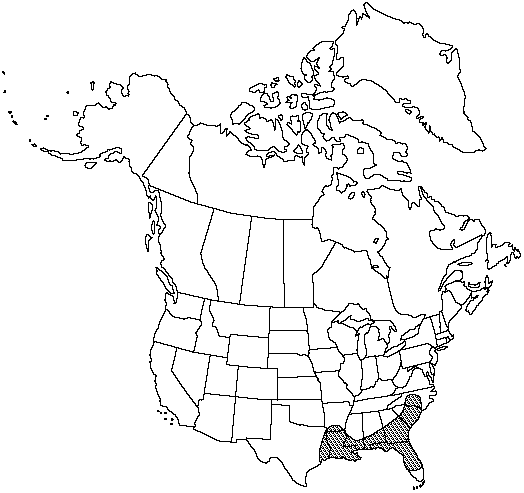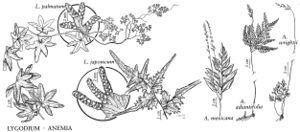Difference between revisions of "Lygodium japonicum"
J. Bot. (Schrader) 1800(2): 106. 1801.
FNA>Volume Importer |
imported>Volume Importer |
||
| (7 intermediate revisions by 2 users not shown) | |||
| Line 8: | Line 8: | ||
}} | }} | ||
|common_names=Japanese climbing fern | |common_names=Japanese climbing fern | ||
| − | |basionyms={{Treatment/ID/ | + | |special_status={{Treatment/ID/Special_status |
| + | |code=I | ||
| + | |label=Introduced | ||
| + | }}{{Treatment/ID/Special_status | ||
| + | |code=F | ||
| + | |label=Illustrated | ||
| + | }} | ||
| + | |basionyms={{Treatment/ID/Basionym | ||
|name=Ophioglossum japonicum | |name=Ophioglossum japonicum | ||
|authority=Thunberg ex Murray | |authority=Thunberg ex Murray | ||
| + | |rank=species | ||
| + | |publication_title=Syst. Veg. ed. | ||
| + | |publication_place=14, 926. May–June 1784 | ||
}} | }} | ||
|synonyms= | |synonyms= | ||
| Line 20: | Line 30: | ||
}}<!-- | }}<!-- | ||
| − | --><span class="statement" id="st- | + | --><span class="statement" id="st-undefined" data-properties=""><b>Stems </b>creeping. <b>Leaves</b> to ca. 3(-30) m. <b>Petioles</b> borne 2-7 mm apart, 10-35 cm. <b>Sterile</b> pinnae on 1.5-3.5 cm stalks, triangular to lanceolate, 2-3-pinnate, 6-15 × 5.5-15 cm; ultimate segments lanceolate, lobed or divided proximally; lobes usually acute at tip and directed toward apex; segment apices long-attenuate to acute; segments not articulate to petiolules, not leaving wiry stalks when detached; blade tissue pubescent abaxially with short, curved hairs. <b>Fertile</b> pinnae on 1-2 cm stalks, lanceolate-triangular, 2-3-pinnate, 5-18 × 4-14 cm; ultimate segments ovate to lanceolate, fringed with fertile lobes, otherwise similiar to sterile segments.</span><!-- |
-->{{Treatment/Body | -->{{Treatment/Body | ||
|habitat=Terrestrial in woods, marshes, roadside ditches, riverbanks, and other wet, disturbed sites in circumneutral soil. | |habitat=Terrestrial in woods, marshes, roadside ditches, riverbanks, and other wet, disturbed sites in circumneutral soil. | ||
|distribution=Ala.;Ark.;Fla.;Ga.;La.;Miss.;N.C.;S.C.;Tex.;Asia in China;Japan. | |distribution=Ala.;Ark.;Fla.;Ga.;La.;Miss.;N.C.;S.C.;Tex.;Asia in China;Japan. | ||
| − | |discussion=<p>Lygodium japonicum is native to eastern Asia. It is commonly naturalized or escaped from cultivation. It has been reported as weedy in southern Alabama and Florida where its dense canopy can eliminate underlying vegetation.</p> | + | |discussion=<p><i>Lygodium japonicum</i> is native to eastern Asia. It is commonly naturalized or escaped from cultivation. It has been reported as weedy in southern Alabama and Florida where its dense canopy can eliminate underlying vegetation.</p> |
|tables= | |tables= | ||
|references= | |references= | ||
| Line 34: | Line 44: | ||
-->{{#Taxon: | -->{{#Taxon: | ||
name=Lygodium japonicum | name=Lygodium japonicum | ||
| − | |||
|authority=(Thunberg ex Murray) Swartz | |authority=(Thunberg ex Murray) Swartz | ||
|rank=species | |rank=species | ||
| Line 46: | Line 55: | ||
|publication title=J. Bot. (Schrader) | |publication title=J. Bot. (Schrader) | ||
|publication year=1801 | |publication year=1801 | ||
| − | |special status= | + | |special status=Introduced;Illustrated |
| − | |source xml=https:// | + | |source xml=https://bitbucket.org/aafc-mbb/fna-data-curation/src/2e0870ddd59836b60bcf96646a41e87ea5a5943a/coarse_grained_fna_xml/V2/V2_184.xml |
|genus=Lygodium | |genus=Lygodium | ||
|species=Lygodium japonicum | |species=Lygodium japonicum | ||
| − | |||
| − | |||
| − | |||
| − | |||
| − | |||
| − | |||
| − | |||
| − | |||
| − | |||
| − | |||
| − | |||
| − | |||
| − | |||
| − | |||
| − | |||
| − | |||
| − | |||
| − | |||
| − | |||
| − | |||
}}<!-- | }}<!-- | ||
-->[[Category:Treatment]][[Category:Lygodium]] | -->[[Category:Treatment]][[Category:Lygodium]] | ||
Latest revision as of 21:21, 5 November 2020
Stems creeping. Leaves to ca. 3(-30) m. Petioles borne 2-7 mm apart, 10-35 cm. Sterile pinnae on 1.5-3.5 cm stalks, triangular to lanceolate, 2-3-pinnate, 6-15 × 5.5-15 cm; ultimate segments lanceolate, lobed or divided proximally; lobes usually acute at tip and directed toward apex; segment apices long-attenuate to acute; segments not articulate to petiolules, not leaving wiry stalks when detached; blade tissue pubescent abaxially with short, curved hairs. Fertile pinnae on 1-2 cm stalks, lanceolate-triangular, 2-3-pinnate, 5-18 × 4-14 cm; ultimate segments ovate to lanceolate, fringed with fertile lobes, otherwise similiar to sterile segments.
Habitat: Terrestrial in woods, marshes, roadside ditches, riverbanks, and other wet, disturbed sites in circumneutral soil.
Distribution

Ala., Ark., Fla., Ga., La., Miss., N.C., S.C., Tex., Asia in China, Japan.
Discussion
Lygodium japonicum is native to eastern Asia. It is commonly naturalized or escaped from cultivation. It has been reported as weedy in southern Alabama and Florida where its dense canopy can eliminate underlying vegetation.
Selected References
None.
